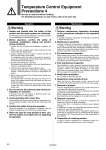
m-03-3c-seihin_en 65 / 77
10秒後にBOOKのページに移動します
Temperature Control Equipment Precautions 4 Be sure to read this before handling. For detailed precautions on each series, refer to the main text. Operation Warning 1. Handle and operate after the safety of this product and the whole system are confirmed. For this product and incidental equipment, operate this product by a knowledgeable and experienced person. 2. Before operation, confirm the safety of mounting, installation, piping and electric wiring conditions. 1. Confirm that the mounting and installation conditions are safe. 2. Confirm that the circulating fluid is filled and that the fluid level is within the display range. 3. Confirm whether the valve is open or closed and that the hose and resin tube are not twisted. It is dangerous when the valve in the piping is closed because the circulating fluid and the facility water will not flow and the fluid pressure will increase. 4. Confirm the flow direction of the fluid. Be certain that the flow direction of the fluid (Inlet/Outlet direction) is connected correctly. 5. Confirm that the electrical wiring condition is safe. Incorrect wiring will lead to malfunction or breakage of the product. Confirm that there is no error in wiring before operation. 6. When using the product with a 3-phase power supply, confirm the connection. If the phase order is incorrect, the pump, etc. will run in reverse, or the phase-reversal relay will activate and the product will not operate. In this case, after cutting off the main power supply, reverse 2 wires out of the 3 wires and connect them in the correct phase order. 3. Do not remove the external panel during energization or operation. If removed, there are the dangers of electrical shock, burn, frostbite, injury from a rotating object. 4. Avoid operating with a lower flow. Avoid operating with a lower flow because the temperature control may become unstable or the service life of the pump may shorten. 5. Confirm the safety during the operation. During the operation, if an emergency is detected, stop this product immediately and cut off the power supply breaker. 6. When not used for long periods of time, confirm the safety once again prior to beginning its operation. Maintenance Warning 1. Perform maintenance inspection according to the procedures indicated in the operation manual. If handled improperly, malfunction and damage of machinery or equipment may occur. 2. Maintenance operations Improper handling of compressed air is dangerous. Therefore, in addition to observing the product specifications, replacement of elements and other maintenance activities should be performed by personnel having sufficient knowledge and experience pertaining to pneumatic equipment. 3. Pre-maintenance inspection When removing this product, cut off the electric power, and be certain to shut off the supply pressure and exhaust the compressed air in the system. Proceed only after confirming that all pressure has been released to the atmosphere. 4. Post maintenance inspection After installation or repair, reconnect compressed air and electricity and conduct appropriate inspections to confirm proper operation. If there is an audible air leakage, or if the equipment does not operate properly, stop operation and confirm that the equipment is installed correctly. 5. Modification prohibited Do not modify or reconstruct the unit. 6. Stopping for long periods of time When not using for long periods of time, remove the fluid (circulating fluid, facility water) and cut off the main power supply. 7. Removal of product Take the stop/inspection measures and confirm that there is no danger before the product is removed. In the event of removing the product, discharge the used fluid and clean the inside of the piping. When a dangerous fluid or polluted fluid is left, it is likely that the polluted area will be enlarged or an accident will occur. 8. Disposal of product When the product is disposed, it must be in compliance the ordinance or rules of the local municipality. Ask for help from a professional industrial waste disposal company. In particularly, in case of a refrigerated type product, entrust a company to collect the refrigerant, etc. In that case, the customer may be requested to submit a certificate that is showing the type of operating fluid and whether any quantity is left. These procedures are the responsibility of the customer. 9. Preparation of a backup product In order to keep the downtime of a customer's system to a minimum, prepare a backup product, when necessary. 60